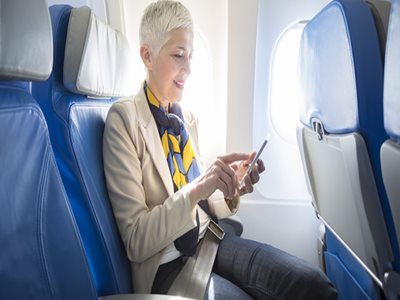Not only does the KuStream® 1000 antenna system cost-effectively provide the speed, reliability and coverage required by passengers, it provides airlines the opportunity to present a richer connectivity offering, especially for shorter flights.
The uptake has been so rapid that KuStream® 1000 systems have already given passengers more than 15 million hours of internet access on more than 1,000 planes.

THE VISION
High reliability antenna system that enables gate-to-gate in-flight broadband.
THE MISSION
The funny thing about the human psyche is that, once we’ve got used to something in one area of our life, for however short a time, we expect it everywhere. And we reserve the right to be annoyed if it’s not.
Nowhere is this more evident than with personal electronic devices. We’ve got so used to using personal devices away from home as fully as we do in it, that we now view any connectivity black hole, anywhere, as poor service. That’s not something any business wants to be associated with.
Yet the airline industry – often associated with innovative ideas – has struggled to keep pace in this area. Despite a relaxation of personal electronic device usage rules by the US Federal Aviation Administration (FAA) and the Federal Communications Commission (FCC) in 2013, in-flight connectivity has remained doggedly behind the experience on the ground. That’s because, operating at some 32,000 feet above cell towers, aeroplanes spend much of their time away from strong land-based signals, for example when cruising over oceans.
The alternative is to use satellites to deliver internet to the plane. But conventional technology in this area has been expensive and with slower connections that can’t adequately support streaming media, now the top user demand. Unsurprisingly, users have been rejecting lower-level service in favour of seat-back entertainment.
The profit impact of this for operators is significant. With new connectivity expectations, passengers are likely to consider the availability and standard of Wi-Fi when selecting an airline, which means seat sales are at stake. On-board and after-sales potential is also compromised as seat-back entertainment systems don’t have the same flexibility to personalise content or facilitate ongoing engagement.
This is no small matter. With air passenger numbers set to double in the next 15 years, airline operators are under pressure not only to lower ticket costs while increasing services; but to do so while containing their operating costs and reducing environmental impact (especially fuel usage). They can only do this by rethinking every area of aeroplane design to maximise efficiency.
The Innovation
In the area of in-flight Wi-Fi, Smiths Interconnect flew to the rescue. Its revolutionary antenna is enabling a new generation of satellite-based broadband services to be cost-effectively deployed by airlines.
KuStream® 1000 operates on global Ku-band networks and High-Throughput Satellites (HTS) that make it possible to provide the increased bandwidth required for in-flight media streaming, fast internet browsing and other data-hungry apps used by today’s passengers.
Crucially, KuStream® has a unique geographical skew angle range. In simple terms, this means it can track and move to maintain contact with a satellite for far longer than previously possible. This secures consistent and seamless passenger service through manoeuvres such as banking, and compensates for handover between satellites. It also means it requires fewer satellites for network operation, which significantly reduces costs.
The Smiths Effect
Not only does the KuStream® 1000 antenna system cost-effectively provide the speed, reliability and coverage required by passengers, it provides airlines the opportunity to present a richer connectivity offering, especially for shorter flights.
The uptake has been so rapid that KuStream® 1000 systems have already given passengers more than 15 million hours of internet access on more than 1,000 planes. With this technological breakthrough, it’s a trend set to continue. Juniper Research* has forecasted that commercial aircraft adopting in-flight Wi-Fi services will reach 14,419 globally by 2022: that’s more than half of the global fleet, compared with just under a quarter (5,243) in 2017.
Good news for passengers, yes – who can now enjoy both better entertainment and be more productive while flying. But also good news for airlines. By supporting passengers’ device preferences, an airline will not only attract more passengers but Juniper believes they can expect to increase monthly in-flight entertainment revenues by 30% per aircraft by 2022.

